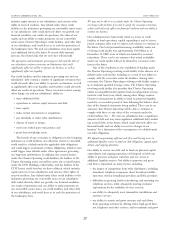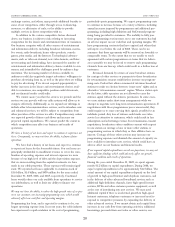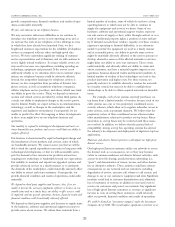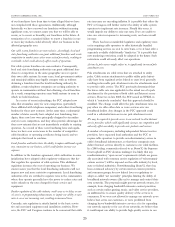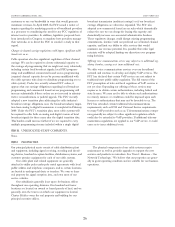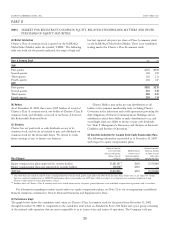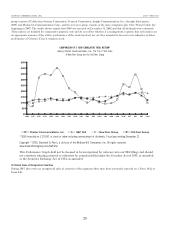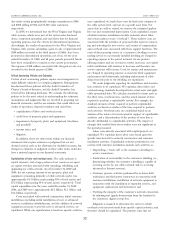Charter 2007 Annual Report Download - page 37
Download and view the complete annual report
Please find page 37 of the 2007 Charter annual report below. You can navigate through the pages in the report by either clicking on the pages listed below, or by using the keyword search tool below to find specific information within the annual report.
customers or use our bandwidth in ways that would generate
maximum revenues. In April 2007, the FCC issued a notice of
inquiry regarding the marketing practices of broadband providers
as a precursor to considering the need for any FCC regulation of
internet service providers. In addition, legislative proposals have
been introduced in Congress to mandate how providers manage
their networks or to direct the FCC to conduct a study in that
regard.
Changes in channel carriage regulations could impose significant addi-
tional costs on us.
Cable operators also face significant regulation of their channel
carriage. We can be required to devote substantial capacity to
the carriage of programming that we might not carry voluntarily,
including certain local broadcast signals; local PEG program-
ming; and unaffiliated, commercial leased access programming
(required channel capacity for use by persons unaffiliated with
the cable operator who desire to distribute programming over a
cable system). Under two recently released FCC orders, it
appears that our carriage obligations regarding local broadcast
programming and commercial leased access programming will
increase substantially if these orders are not reversed in adminis-
trative reconsiderations or judicial appeals. The FCC recently
adopted a new transition plan addressing the cable industry’s
broadcast carriage obligations once the broadcast industry migra-
tion from analog to digital transmission is completed in February
2009. Under the FCC’s transition plan, most cable systems will
be required to offer both an analog and digital version of local
broadcast signals for three years after the digital transition date.
This burden could increase further if we are required to carry
multiple programming streams included within a single digital
broadcast transmission (multicast carriage) or if our broadcast
carriage obligations are otherwise expanded. The FCC also
adopted new commercial leased access rules which dramatically
reduce the rate we can charge for leasing this capacity and
dramatically increase our associated administrative burdens.
These regulatory changes could disrupt existing programming
commitments, interfere with our preferred use of limited channel
capacity, and limit our ability to offer services that would
maximize our revenue potential. It is possible that other legal
restraints will be adopted limiting our discretion over program-
ming decisions.
Offering voice communications service may subject us to additional reg-
ulatory burdens, causing us to incur additional costs.
We offer voice communications services over our broadband
network and continue to develop and deploy VoIP services. The
FCC has declared that certain VoIP services are not subject to
traditional state public utility regulation. The full extent of the
FCC preemption of state and local regulation of VoIP services is
not yet clear. Expanding our offering of these services may
require us to obtain certain authorizations, including federal and
state licenses. We may not be able to obtain such authorizations
in a timely manner, or conditions could be imposed upon such
licenses or authorizations that may not be favorable to us. The
FCC has extended certain traditional telecommunications
requirements, such as E911 and Universal Service requirements
to many VoIP providers such as us. Telecommunications compa-
nies generally are subject to other significant regulation which
could also be extended to VoIP providers. If additional telecom-
munications regulations are applied to our VoIP service, it could
cause us to incur additional costs.
ITEM 1B. UNRESOLVED STAFF COMMENTS.
None.
ITEM 2. PROPERTIES.
Our principal physical assets consist of cable distribution plant
and equipment, including signal receiving, encoding and decod-
ing devices, headend reception facilities, distribution systems, and
customer premise equipment for each of our cable systems.
Our cable plant and related equipment are generally
attached to utility poles under pole rental agreements with local
public utilities and telephone companies, and in certain locations
are buried in underground ducts or trenches. We own or lease
real property for signal reception sites, and own most of our
service vehicles.
Our subsidiaries generally lease space for business offices
throughout our operating divisions. Our headend and tower
locations are located on owned or leased parcels of land, and we
generally own the towers on which our equipment is located.
Charter Holdco owns the real property and building for our
principal executive offices.
The physical components of our cable systems require
maintenance as well as periodic upgrades to support the new
services and products we introduce. See “Item 1. Business – Our
Network Technology.” We believe that our properties are gener-
ally in good operating condition and are suitable for our business
operations.
CHARTER COMMUNICATIONS, INC. 2007 FORM 10-K
26



